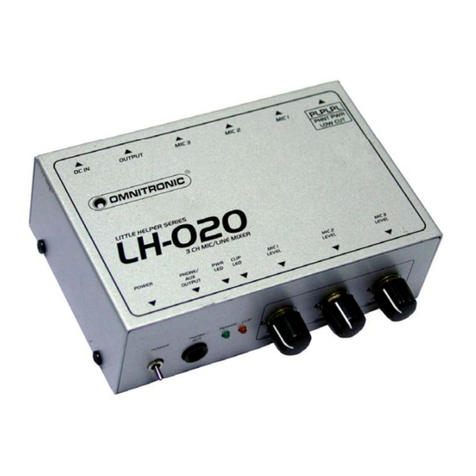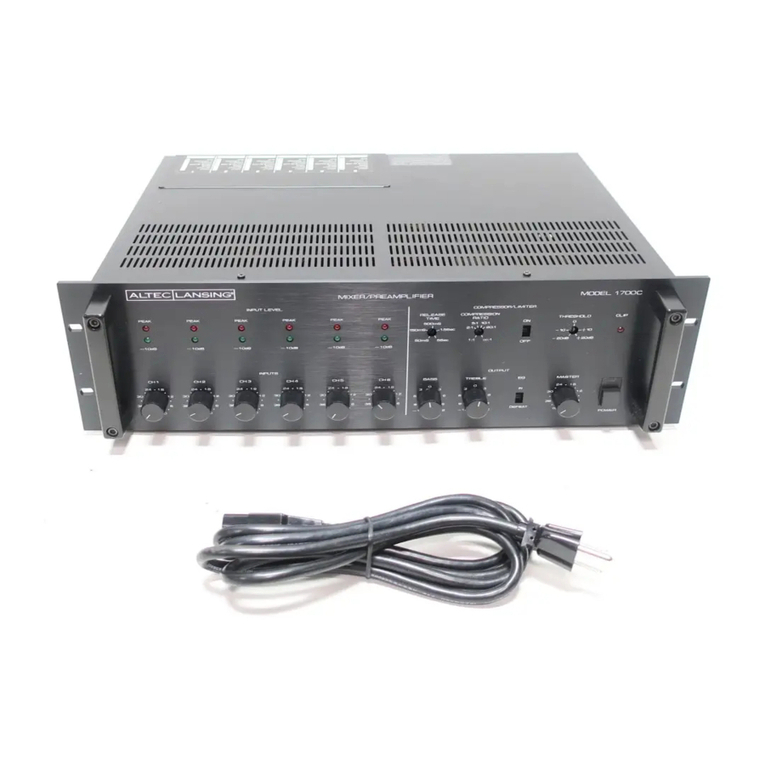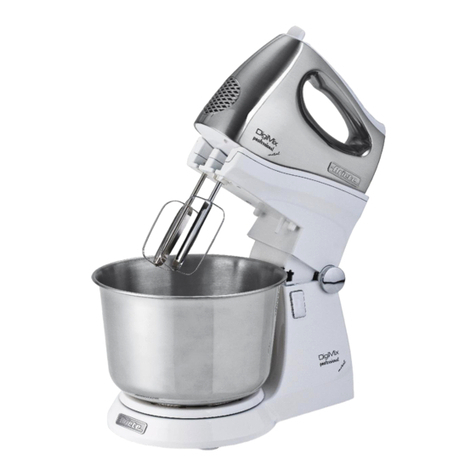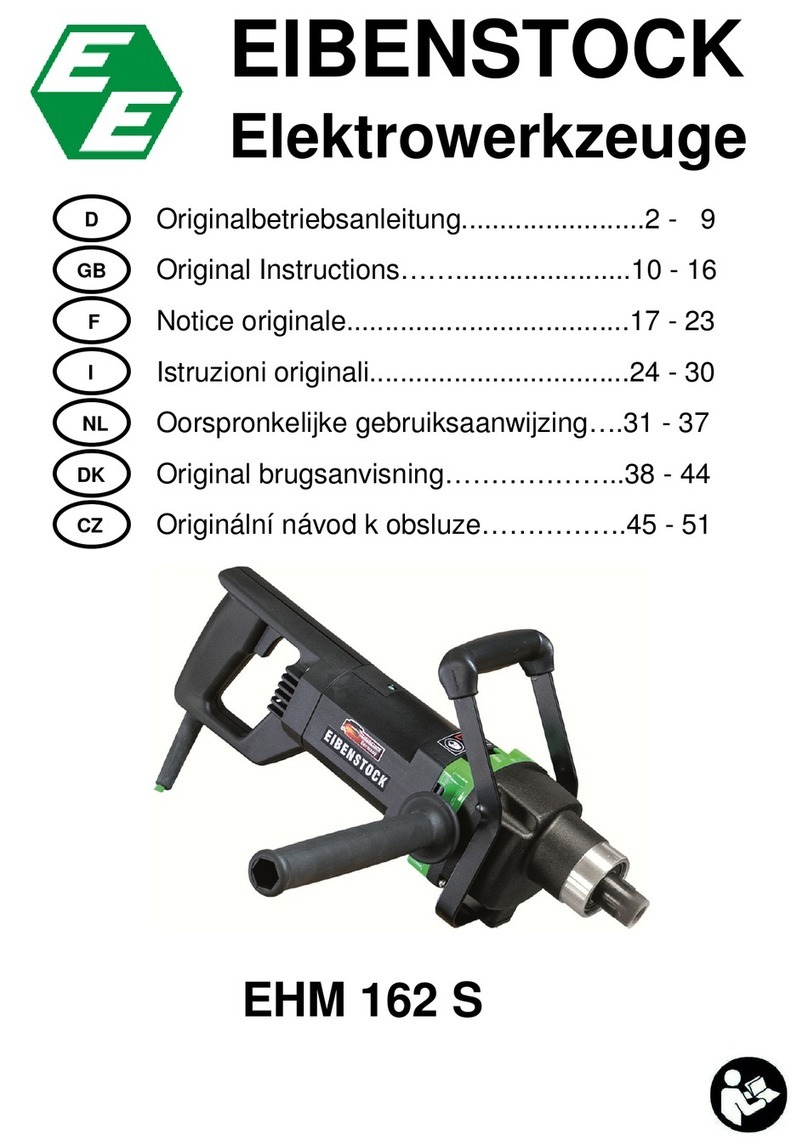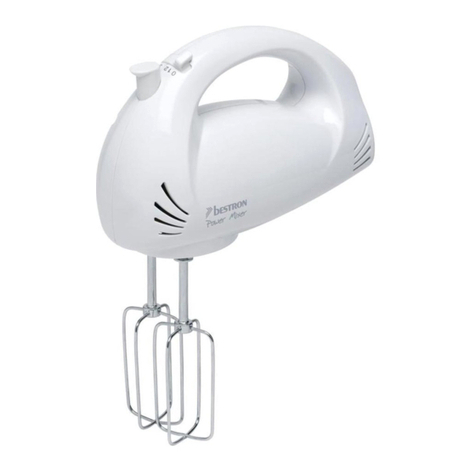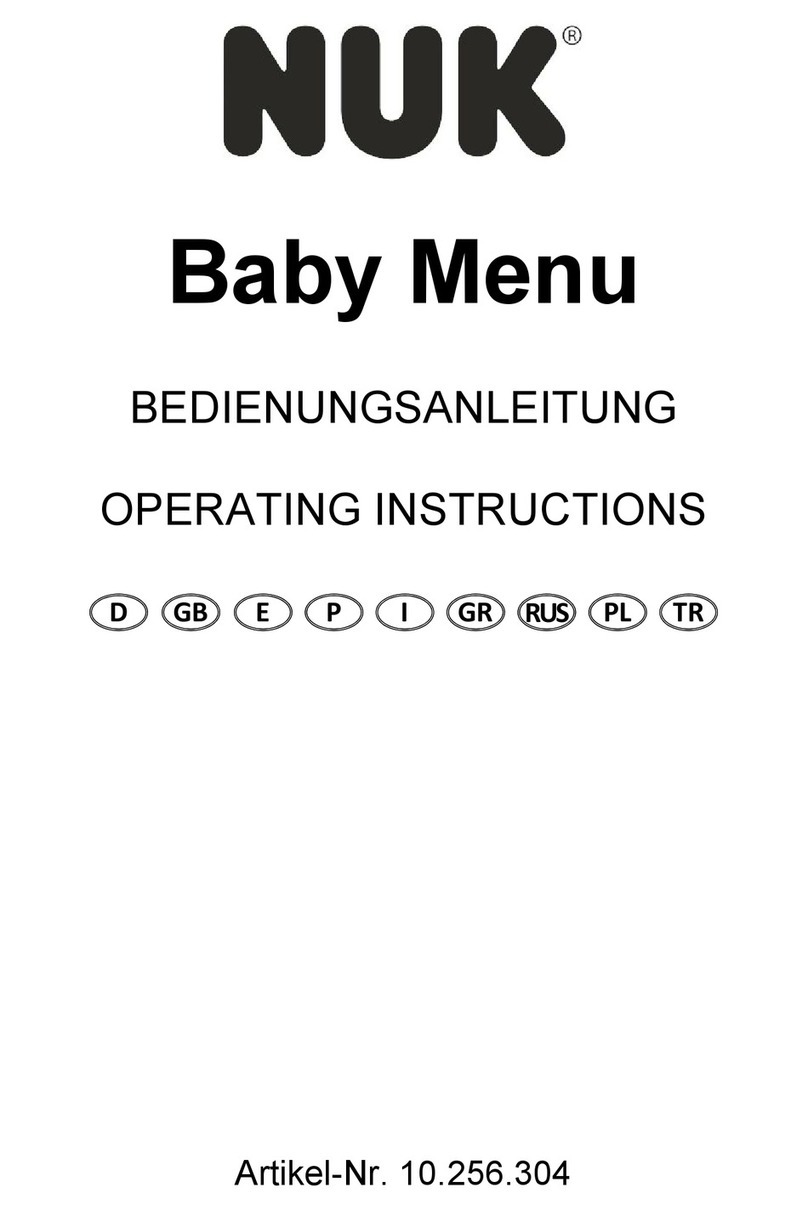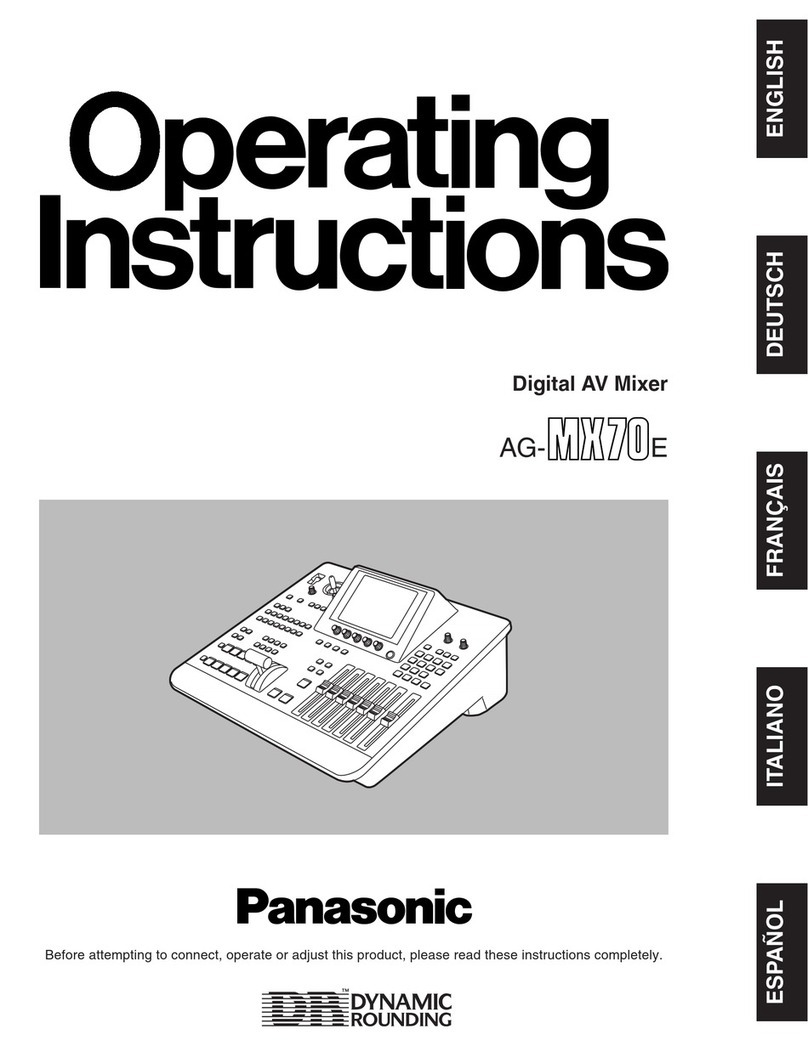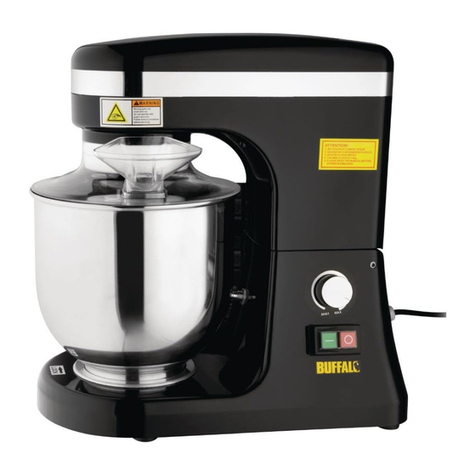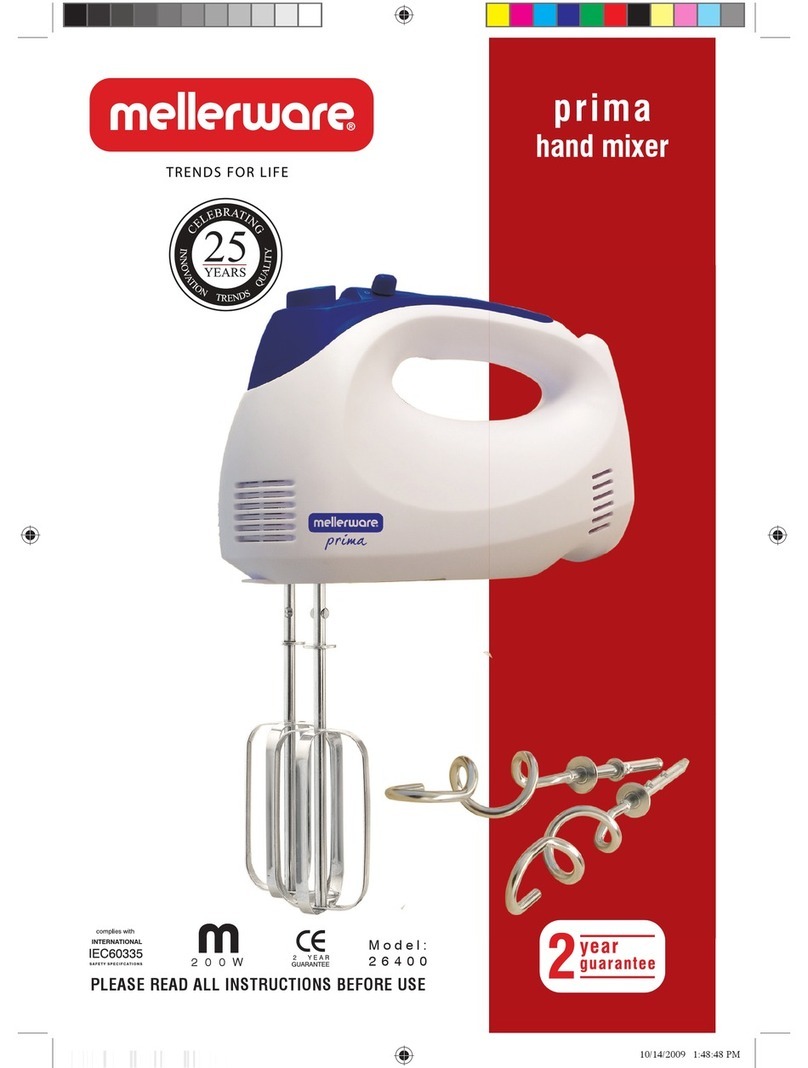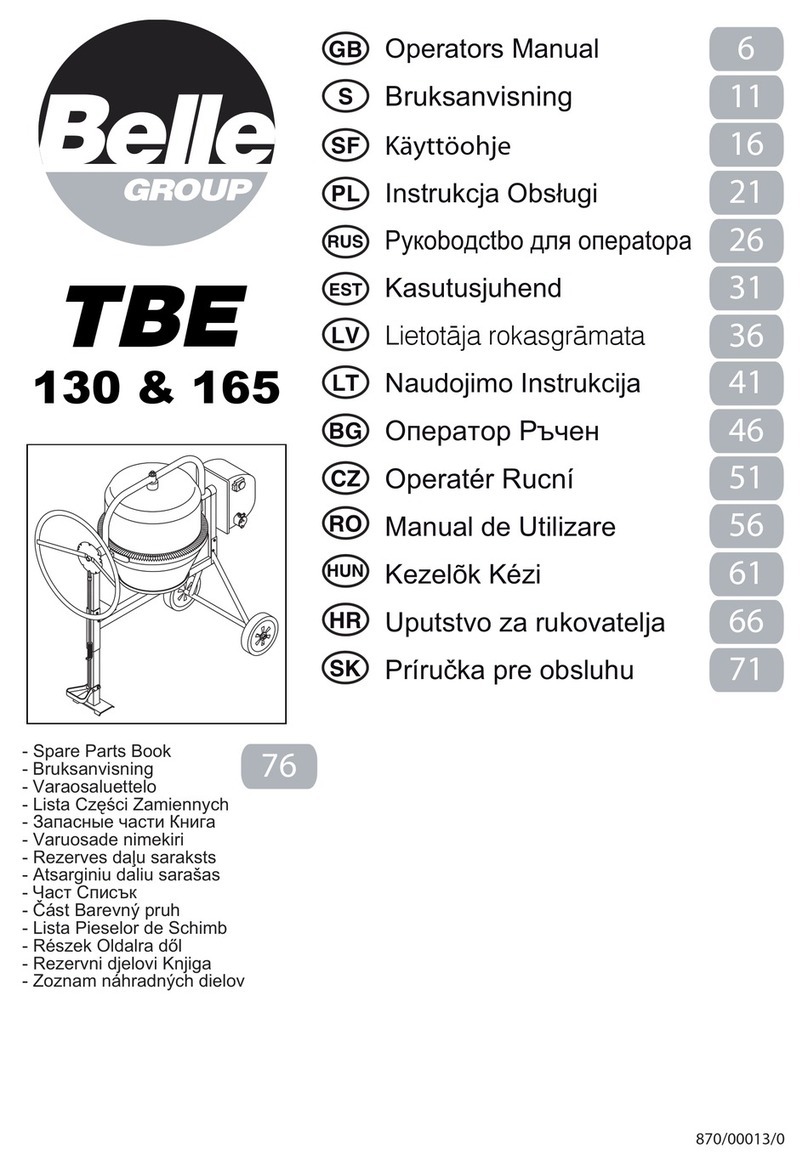Omnitronic MX-410 User manual

©Copyright
Nachdruck verboten!
Reproduction prohibited!
Für weiteren Gebrauch aufbewahren!
Keep this manual for future needs!
BEDIENUNGSANLEITUNG
USER'S MANUAL
MX-410
Multichannel Mixer

00041733.DOC, Version 2.0
2/26

00041733.DOC, Version 2.0
3/26
Inhaltsverzeichnis/
Table of contents
1. EINFÜHRUNG............................................................................................................................................... 4
2. SICHERHEITSHINWEISE............................................................................................................................. 4
3. BESTIMMUNGSGEMÄSSE VERWENDUNG .............................................................................................. 5
4. GERÄTEBESCHREIBUNG .......................................................................................................................... 6
4.1 Features................................................................................................................................................... 6
4.2 Bedienelemente und Anschlüsse............................................................................................................. 7
5. INSTALLATION .......................................................................................................................................... 10
5.1 Rackinstallation...................................................................................................................................... 10
5.2 Anschlüsse............................................................................................................................................. 10
6. BEDIENUNG ............................................................................................................................................... 12
6.1 Grundeinstellung der Eingangskanäle................................................................................................... 12
6.2 Grundeinstellung der Ausgangskanäle.................................................................................................. 12
6.3 Überblenden zwischen zwei Kanälen/Mischen der Signalquellen......................................................... 13
6.4 Durchsagen über das DJ-Mikrofon ........................................................................................................ 13
6.5 Vorhören der Kanäle.............................................................................................................................. 13
7. REINIGUNG UND WARTUNG.................................................................................................................... 14
7.1 Crossfader austauschen ........................................................................................................................ 14
8. TECHNISCHE DATEN................................................................................................................................ 15
1. INTRODUCTION ......................................................................................................................................... 16
2. SAFETY INSTRUCTIONS .......................................................................................................................... 16
3. OPERATING DETERMINATIONS.............................................................................................................. 17
4. DESCRIPTION ............................................................................................................................................ 18
4.1 Features................................................................................................................................................. 18
4.2 Operating elements and connections .................................................................................................... 19
5. INSTALLATION .......................................................................................................................................... 22
5.1 Rack installation..................................................................................................................................... 22
5.2 Connections ........................................................................................................................................... 22
6. OPERATION ............................................................................................................................................... 24
6.1 Basic adjustment of the input channels ................................................................................................. 24
6.2 Basic adjustment of the output channels ............................................................................................... 24
6.3 Crossfading between two channels/mixing the signal sources ............................................................. 24
6.4 Announcements via the DJ microphone ................................................................................................ 25
6.5 Prefader listening to the channels ......................................................................................................... 25
7. CLEANING AND MAINTENANCE ............................................................................................................. 25
7.1 Replacing the crossfader ....................................................................................................................... 26
8.TECHNICAL SPECIFICATIONS.................................................................................................................. 26
Diese Bedienungsanleitung gilt für die Artikelnummern: 10006750,
This user manual is valid for the article numbers: 10006751
Das neueste Update dieser Bedienungsanleitung finden Sie im Internet unter:
You can find the latest update of this user manual in the Internet under:
www.omnitronic.com

00041733.DOC, Version 2.0
16/26
USER MANUAL
MX-410
Multichannel Mixer
CAUTION!
Keep this device away from rain and moisture!
Unplug mains lead before opening the housing!
For your own safety, please read this user manual carefully before you initially start-up.
Every person involved with the installation, operation and maintenance of this device has to
- be qualified
- follow the instructions of this manual
- consider this manual to be part of the total product
- keep this manual for the entire service life of the product
- pass this manual on to every further owner or user of the product
- download the latest version of the user manual from the Internet
1. INTRODUCTION
Thank you for having chosen the OMNITRONIC multichannel mixer MX-410. You have acquired a
reliable and powerful device. If you follow the instructions given in this manual, we can assure you that you
will enjoy this device for many years.
Unpack your mixer.
2. SAFETY INSTRUCTIONS
This device has left our premises in absolutely perfect condition. In order to maintain this condition and to
ensure a safe operation, it is absolutely necessary for the user to follow the safety instructions and warning
notes written in this user manual.
Important:
Damages caused by the disregard of this user manual are not subject to warranty. The dealer will
not accept liability for any resulting defects or problems.
Please make sure that there are no obvious transport damages. Should you notice any damages on the
power unit or on the casing, do not take the device into operation and immediately consult your local dealer.
This device falls under protection-class III. The device always has to be operated with an appropriate
transformer.

00041733.DOC, Version 2.0
17/26
Always plug in the power unit least. Make sure that the power-switch is set to OFF position before you
connect the device to the mains.
Keep away from heaters and other heating sources!
If the device has been exposed to drastic temperature fluctuation (e.g. after transportation), do not switch it
on immediately. The arising condensation water might damage your device. Leave the device switched off
until it has reached room temperature.
Never put any liquids on the device or close to it. Should any liquid enter the device nevertheless, disconnect
from mains immediately. Please let the device be checked by a qualified service technician before you
operate it again. Any damages caused by liquids having entered the device are not subject to warranty!
Always disconnect from the mains, when the device is not in use or before cleaning it.
Please note that damages caused by manual modifications on the device or unauthorized operation by
unqualified persons are not subject to warranty.
CAUTION: Turn the amplifier on last and off first!
Keep away children and amateurs!
HEALTH HAZARD!
By operating an amplifying system, you can produce excessive sound pressure levels that may
lead to permanent hearing loss.
There are no serviceable parts inside the device. Maintenance and service operations are only to be carried
out by authorized dealers.
3. OPERATING DETERMINATIONS
The multichannel mixer MX-410 for two PA zones features four stereo input cannels, one DJ microphone
channel and a replaceable crossfader and has been designed for general professional PA applications.
This product is allowed to be operated with an alternating current of 2 x 15 V, 50 Hz and was designed for
indoor use only.
The device must only be operated with the included power unit. The power unit falls under protection-class 2
and the mixer under protection-class 3.
Do not shake the device. Avoid brute force when installing or operating the device.
When choosing the installation-spot, please make sure that the device is not exposed to extreme heat,
moisture or dust. There should not be any cables lying around. You endanger your own and the safety of
others!
The ambient temperature must always be between -5° C and +45° C. Keep away from direct insulation
(particularly in cars) and heaters.
The relative humidity must not exceed 50 % with an ambient temperature of 45° C.
This device must only be operated in an altitude between -20 and 2000 m over NN.
Operate the device only after having familiarized with its functions. Do not permit operation by persons not
qualified for operating the device. Most damages are the result of unprofessional operation!
Never use spray cleaners in order to clean the faders!
Never use solvents or aggressive detergents in order to clean the device! Rather use a soft and damp cloth.

00041733.DOC, Version 2.0
18/26
Please use the original packaging if the device is to be transported.
Please consider that unauthorized modifications on the device are forbidden due to safety reasons!
Never remove the serial barcode from the device as this would make the guarantee void.
If this device will be operated in any way different to the one described in this manual, the product may suffer
damages and the guarantee becomes void. Furthermore, any other operation may lead to dangers like short-
circuit, burns, electric shock, etc.
4. DESCRIPTION
4.1 Features
Professional 4+1-channel mixer
• High-grade discotheque mixer with convincing sound and 2 master channels
• 4 input channels with gain control, 3-band equalizer, cue button and smooth, durable fader
• 1 DJ microphone channel with 3-band equalizer, level control, on air and talkover selector
• Prefader listening to all input channels and the master output via adjustable headphones output, with cue
mix/split function and 10-digit LED level meter
• Replaceable crossfader for crossfading between input channels
• 2 separately controllable master channels with mono/stereo selector switch
• Master channel 1 with fader and 10-digit stereo LED level meter, switchable to master channel 2
• 7-band stereo equalizer for master channel 1; assignable to master channel 2 and booth output
• Adjustable monitor output (DJ booth)
• 2 recording outputs, independent of the master and with on/off switch for DJ microphone signals
• Inputs: 10x line (stereo RCA), additonally 1x line at the front panel (stereo RCA/3.5 mm jack); 2x phono/line
(stereo RCA), switchable; 1x DJ microphone (XLR/6.3 mm jack), 2x microphone (6.3 mm jack) and
headphones (3.5 mm/6.3 mm jack)
• Outputs: 2x master (stereo XLR/stereo RCA), 1x booth (stereo RCA/6.3 mm stereo jack, bal.) and 2x
record (stereo RCA)
• Operation via supplied power unit
• 19" dimensions for rack installation, 5 U

00041733.DOC, Version 2.0
19/26
4.2 Operating elements and connections
1 LED REAR MIC IN
Lights blue when connecting a microphone to the rea
r
microphone input DJ MIC.
2 Microphone input DJ MIC
• Input for connecting a DJ microphone via an XLR plug
or 6.3 mm plug, as an alternative to the connector on
the rear panel.
• With the corresponding input selector switch at the rea
r
panel the DJ microphone input can be switched to line
input for mono units with line level output.
3 Buttons CUE
Buttons for monitoring the input channels 1-4 ahead o
f
the respective channel fader via headphones connected
to the jacks PHONES. With the button pressed, the blue
LED lights to immediately indicate that a channel is
monitored.
4 Tone controls
3-band equalizer for the DJ microphone: TREBLE,
MIDDLE, BASS.
5 Level control
Level control for the DJ microphone.
6 Microphone channel on/off
On/off switch for the DJ microphone channel. With the
button pressed (red LED lights), the DJ microphone is
switched on.
7 Talkover on/off
On/off switch for the talkover function. With the button
pressed (blue LED lights), the levels of the channels 1-4
are automatically attenuated by 15 dB when
announcements are made with the DJ microphone.
9 Assignment switches
Select the channel for crossfading with the crossfader. I
f
crossfading is not required, the channel can be switched
directly to the master signal.
• left position A: channel switched to side A
• center position M: channel switched to master signal
• right position B: channel switched to side B
10 Crossfader
For crossfading between two of the channels 1-4, which
can be selected with the assignment switches. In mid-
position, both channels can be heard at the same
volume.
11 Fader CUE MIXING
For selecting and crossfading the monitoring signal fo
r
the headphones output and the cue level meter:
• left position CUE: The prefader level of the input
channel of which the button CUE is pressed is
monitored and indicated by the cue level meter.
• right position MASTER: The music program currently
playing is monitored ahead of the master fader and the
output controls MASTER 2 and BOOTH and indicated
by the cue level meter.
12 Gain controls
A
djust the input amplification for channels 1-4.
13 Level control CUE LEVEL
Level control for the headphones output.
14 Master fader
Level control for the master channel 1.

00041733.DOC, Version 2.0
20/26
22 Output REC(CORD)
Stereo output (RCA) for connecting an additional
recording unit. The recording level is independent of the
position of the master fader and the output controls
MASTER 2 and BOOTH LEVEL.
23 Inputs LINE 10
Inputs (optionally 3.5 mm jack or stereo RCA) fo
r
connecting an additonal unit with line level output (e.g.
CD player).
24 Assignment switches EQ TO BOOTH/EQ TO
MASTER 2
A
ssignment switches (with LED), to assign the equalize
r
to the output BOOTH and to the master channel 2.
• button EQ TO BOOTH pressed (blue LED lights):
equalizer is switched to the output BOOTH
• button EQ TO MASTER 2 pressed (blue LED lights):
equalizer is switched to the master channel 2
25 Equalizer L/R
7-band stereo equalizer for the master channel 1 and
depending on the assignment switches EQ TO BOOTH
and EQ TO MASTER 2, for the output BOOTH and the
master channel 2.
26 Output level LED meter L/R
10-digit LED meter; depending on the position of the
selector switch LED METER it indicates the level o
f
master channel 1 or of master channel 2 within the range
of -24 dB to +9 dB.
27 Cue level meter
10-digit LED meter; depending on the position of the
fader CUE MIXING it indicates the prefader level of the
input channel for which the button CUE is pressed or the
master signal ahead of the master fader and the output
controls MASTER 2 and BOOTH, within the range of -24
dB to +9 dB. The indicated level is dependent on the
control CUE LEVEL for the headphones volume.
28 Input selectors
For selecting the input source for the channels 1-4.
15 Headphones input
Input (optionally 3.5 mm jack or 6.3 mm jack) fo
r
connecting stereo headphones (impedance ≥8 Ω).
16 Selector switch CUE MODE
For selecting the monitoring mode for the headphones
output:
•SPLIT (button pressed, red LED lights): The prefade
r
level (mono) is on one side and the output signal (mono)
is on the other side of the headphones.
•MIX (button released, blue LED lights): A mixed signal
of prefader level and master signal is on both sides o
f
the headphones.
17 Control BOOTH LEVEL
Level control for the output BOOTH.
18 Control MASTER 2
Level control for the master channel 2.
19 Selector switch LED METER
Button for switching the LED level meter between the two
master channels.
•M2 (button pressed, red LED lights): level indication o
f
master channel 2
•M1 (button released, blue LED lights): level indication o
f
master channel 1
20 Selector switch DJ MIC TO REC
Switches the DJ microphone channel at the outputs
REC(CORD) on and off.
•+(button pressed, red LED lights): recordings with
microphone signal
•-(button released, blue LED lights): recordings without
microphone signal
21 Selector switch MODE
Stereo/mono switch for both master channels.
•MONO (button pressed, red LED lights): maste
r
channels are switched to mono
•STEREO (button released, blue LED lights): maste
r
channels are switched to stereo

00041733.DOC, Version 2.0
21/26
29 AC connection
Plug in the mains cable of the supplied power unit here
and fix it with the union nut.
30 Power on/off
Press this button to turn the unit on and off.
31 Master outputs
• Stereo outputs (optionally XLR, bal. or RCA) of both
master channels for connecting amplifiers or other units
with line level inputs.
• The outputs can be switched to mono by pressing the
selector switch MODE at the front panel.
32 Output BOOTH
Stereo output (optionally RCA or 6.3 mm jack, bal.) fo
r
connecting a further amplifier, e.g. for the monitoring
system or PA application in a secondary room.
33 Output REC(ORD)
Stereo output (RCA) for connecting a recording unit. The
recording level is independent of the position of the
master fader and the output controls MASTER 2 and
BOOTH.
34 Inputs LINE 1-10
Stereo inputs (RCA) for channels 1-4 for connecting units
with line level outputs (e.g. CD players).
35 Inputs PH/LINE
• Stereo inputs (RCA) for channel 1 and channel 2 fo
r
connecting turntables with magnetic system.
• With the corresponding input selector switches the
inputs can be switched to line level.
36 GND (ground terminals)
Ground clamping screws for turntables connected to
channel 1 and channel 2.
37 Microphone input DJ MIC
• Rear microphone input (6.3 mm jack) for the DJ
microphone channel. When connecting a microphone,
the LED REAR MIC IN on the front panel lights up.
• With the corresponding input selector switch the DJ
microphone input can be switched to line input for mono
units with line level output.
38 Input selector switch
Switches the microphone input DJ MIC to line input.
39 Input selector switches
Switches the phono inputs to line inputs.
40 Microphone inputs
6.3 mm jacks for channel 3 and channel 4 for connecting
microphones.
41 Input selector switches
Switches the channels 3 and 4 between microphone input
and line input.
42 Level selector switches
Switches the level at the master outputs 1 and 2 between
0.75 V and 1.5 V.

00041733.DOC, Version 2.0
22/26
5. INSTALLATION
5.1 Rack installation
Install the unit on a plane surface or in your rack. For 19" (483 mm) rack installation, 5 units are required.
When mounting the unit into the rack, please make sure that there is enough space around the device so
that the heated air can be passed on. Steady overheating will damage your device. You can fix the unit with
four screws M6 in the rack.
5.2 Connections
Switch off the mixer prior to connecting any units or to changing any existing connections.
1 Connect the stereo audio sources to the corresponding RCA jacks of channels 1-4 (white jack = left; red
jack = right):
• Connect units with line level output (e.g. CD players) to the jacks LINE.
• Connect turntables with magnetic system to the jacks PH/LINE.
• If your turntable is equipped with a separate ground lead, connect it to the corresponding clamping
screw GND.

00041733.DOC, Version 2.0
23/26
2 You can connect three microphones: a DJ microphone to the DJ microphone channel DJ MIC and two
further microphones to the microphone channels MIC 1 and MIC 2.
• Connect a DJ microphone via an XLR plug or a 6.3 mm plug to the front input DJ MIC or via 6.3 mm
plug to the rear input DJ MIC. When connecting a microphone to the rear input, the control LED REAR
MIC IN lights at the front panel. With the rear input selector switch it is possible to switch the
microphone input DJ MIC to line input for mono units with line level output (e.g. wireless receivers)
• Two further microphones can be connected via 6.3 mm plugs to the rear inputs MIC 1 and MIC 2.
3 For connecting amplifiers, several stereo outputs with individual level controls are available:
• Connect the main amplifiers to the outputs MASTER 1 and MASTER 2, optionally to the balanced XLR
output or to the unbalanced RCA output.
• If a monitoring system is available, connect the amplifier of the monitoring system to the stereo output
BOOTH.
4 For analog sound recordings, connect the recording units to the outputs REC(ORD). The recording level
is independent of the position of the master fader and the output controls MASTER 2 and BOOTH
LEVEL. With an audio interface such as the OMNITRONIC DDI 4x4 you can also digitize the analog
output signal of the MX-410 and transfer it to a computer with USB 1.1 or 2.0 connection.
5 For prefader listening to the input channels or for monitoring the current music program ahead of the
master fader and the output controls MASTER 2 and BOOTH LEVEL, it is possible to connect stereo
headphones to the front input PHONES, optionally via 3.5 mm plug or 6.3 mm plug.
6 Connect the power supply unit to the AC input of the MX-410 and the mains plug to a mains socket.
Use the unit only with the supplied power unit. Always disconnect the mains connector when you wish to
change connections, move the unit to a different place or if it is not used for a longer period.

00041733.DOC, Version 2.0
24/26
6. OPERATION
Prior to switching on, set the master fader and the output controls MASTER 2 and BOOTH LEVEL to zero to
avoid damage to the hearing by a volume which is too high when switching on. Switch on the unit with the
power switch. Switch on the connected units. After operation, switch off the unit with the power switch.
6.1 Basic adjustment of the input channels
1 First set all gain controls, equalizer controls and the crossfader to mid-position. Set the crossfader
assignment selectors to the position "M".
2 Use the input selector buttons to select the signal sources connected to the channels 1-4.
3 The level controls of the master channels 1 and 2 determine the total level of all connected audio
sources, which is available at the master outputs. Set the control of the master channel which is used for
the basic setting of the input channels to approx. 2/3 of its maximum.
4 Set the output meter with the selector switch LED METER to the master channel which is used for the
basic setting of the input channels.
5 To control a channel, feed an audio signal (test signal or music piece) to the respective input channel
and advance the channel fader to approx. 2/3 of its maximum. Set all other channel faders to zero.
6 Via the output meter, control the level of the channel with the channel fader. An optimum level control is
obtained if level values in the 0 dB range are shown at average volume. If the red LEDs of the output
meter light up, there is an overload of the channel. After level adjustment, the cannel fader should be at
approx. 2/3 of its maximum. With the fader advanced only slightly or very far, the level must be matched
by adjusting the input amplification. Turn up or turn back the gain control of the channel accordingly. The
cue level meter serves as a control meter: slide the fader CUE MIXING to position “CUE” and press the
button CUE of the channel. Then the cue level meter shows the signal level of the channel ahead of the
channel fader.
7 Repeat the steps for the other connected input channels as described above.
6.2 Basic adjustment of the output channels
The output signal is fed to the adjustable outputs MASTER 1, MASTER 2 and BOOTH and to the recording
outputs REC(ORD) without individual level control.
1 Via the output meter, adjust each master channel to an optimum level with the corresponding master
control. Switch the output meter to the corresponding master channel with the selector switch LED
METER. Usually an optimum level control is obtained if the output meter shows values in the 0 dB range
at average volume. However, if the output level at the master outputs is too high for the following unit,
the master signal must be controlled to a corresponding lower level. If the output level is too low, set the
level selector switch to “1.5 V“.
2 Adjust the sound for the master channel 1 with the 7-band equalizer. To assign the equalizer to the
master channel 2, press the assignment switch EQ TO MASTER 2. Sound adjustments affect the level.
Check the master level with the output meter and readjust it, if required.
3 Adjust the desired signal level for the output BOOTH with the control BOOTH LEVEL. To assign the
equalizer to the output BOOTH, press the assignment switch EQ TO BOOTH.
4 The recording signal at the outputs REC(ORD) is taken off ahead of the output controls, i.e. it is not
affected by the master fader or the output controls MASTER 2 or BOOTH LEVEL. With the selector
switch DJ MIC TO REC the DJ microphone channel can be switched on and off at the outputs
REC(CORD).
5 It is possible to switch the master channels to mono operation with the selector switch STEREO/MONO.
Then the mono signal can be picked up at the master outputs 1 and 2.
6.3 Crossfading between two channels/mixing the signal sources
1 Select the two signal sources for crossfading with the crossfader assignment selectors:
• position A: the channel is switched to side A
• position B: the channel is switched to side B
2 Set the faders of the channels not used to zero and control the two channels selected to an optimum
level with their faders.
3 Now crossfading between the two channels selected is possible:
• crossfader moved to the left: fade-in of side A and fade-out of side B

00041733.DOC, Version 2.0
25/26
• crossfader moved to the right: fade-in of side B and fade-out of side A
• For hearing the signals of the two channels at the same level, set the crossfader to mid-position.
4 For mixing the signals of the other input channels to the music program, advance the corresponding
faders accordingly.
5 If crossfading is not required, the connected audio sources can be switched directly to the master signal:
Set the corresponding assignment selectors to position ”M” and adjust the desired volume ratio of the
audio sources with the channel faders.
6.4 Announcements via the DJ microphone
1 To switch on the DJ microphone at the jack DJ MIC press the button ON AIR (control LED lights red).
2 Adjust the volume of the microphone announcement with the control LEVEL.
3 Adjust the desired sound with the 3-band equalizer. By adjusting the tone controls, the high frequencies
(control TREBLE), the middle frequencies (control MIDDLE) and the low frequencies (control BASS) can
be boosted or attenuated (± 12 dB).
4 To improve the audibility of an announcement during the current music program, press the button
TALKOVER (control LED lights blue) to activate the talkover function. Then during a microphone
announcement, the levels of channels 1-4 are automatically attenuated by 15 dB.
5 To switch off the DJ microphone press the button ON AIR again (control LED off).
6.5 Prefader listening to the channels
The cue function allows monitoring each of the channels 1-4 via headphones even if the corresponding
channel is faded out. Thus, it is possible, e. g. to time the moment for fading in an audio source. Alternatively
it is also possible to monitor the current music program ahead of the master fader or the output controls
MASTER 2 and BOOTH LEVEL.
1 For prefader listening to a channel, press the corresponding switch CUE (control indicator lights) and set
the fader CUE MIXING to the left position “CUE“. Then the cue level meter shows the prefader level of
the selected channel. If the fader CUE MIXING is set to the right position “MASTER”, the current music
program is monitored ahead of the master fader and the output controls MASTER 2 and BOOTH LEVEL
and displayed by the cue level meter.
2 Select the monitoring mode with the selector switch CUE MODE:
•SPLIT (button pressed, red LED lights): The prefader level (mono) is on one side and the output signal
(mono) is on the other side of the headphones.
•MIX (button released, blue LED lights): A mixed signal of prefader level and master signal is on both
sides of the headphones.
3 Adjust the desired headphones volume with the control CUE LEVEL.
7. CLEANING AND MAINTENANCE
Disconnect from mains before starting maintenance operation!
DANGER TO LIFE!
We recommend a frequent cleaning of the device. Please use a soft lint-free and moistened cloth. Never use
alcohol or solvents!
There are no serviceable parts inside the device. Maintenance and service operations are only to be carried
out by authorized dealers.
Should you need any spare parts, please use genuine parts.
Should you have further questions, please contact your dealer.

00041733.DOC, Version 2.0
26/26
7.1 Replacing the crossfader
Procedure:
Step 1: Remove the fader knob.
Step 2: Remove the two outer screws on the fader panel.
Step 3: Take the fader out and unplug the connection cable.
Step 4: Connect the new fader and fix it in the unit.
8.TECHNICAL SPECIFICATIONS
Power supply: 230 V AC, 50 Hz ~,
via supplied power unit
Power consumption: 35 W
Inputs:
DJ MIC (front): combined XLR/6.3 mm jack (bal.)
DJ MIC (rear): 6.3 mm jack (bal.)
MIC 1, MIC 2 (rear): 6.3 mm jack (bal.)
Minimum input voltage: 1 mV RMS
LINE 1-10 (rear): stereo RCA
LINE 10 (front): stereo RCA/3.5 mm jack
Minimum input voltage: 150 mV RMS
PHONO 1,2: stereo RCA
Minimum input voltage: 3 mV RMS
Outputs:
MASTER 1,2: stereo XLR/stereo RCA
Output voltage: 0.75 V/1.5 V RMS (switchable)
BOOTH: stereo RCA/6.3 mm stereo jack
Output voltage: 0.75 V
REC: stereo RCA
Output voltage: 0.75 V
Headphones: 3.5 mm/6.3 mm jack (≥8 Ω)
Tone control (DJ MIC):
1x High: -12 dB to +12 dB/ 10 kHz, ±1 dB
1x Middle: -12 dB to +12 dB/ 1 kHz, ±1 dB
1x Low: -12 dB to +12 dB/ 100 Hz, ±1 dB
Talkover attenuation: -15 dB
Tone control (MASTER):
7-band equalizer: ±15 dB/ 60 Hz, 100 Hz, 400 Hz, 1 kHz,
2.4 kHz 6 kHz, 15 kHz, ±1 dB
S/N ratio: >75 dB
Frequency range: 20-20,000 Hz
Distortion: 0.03%
Dimensions (WxHxD): 482 x 220 x 100 mm (19", 5 U)
Weight: 4 kg
Please note: Every information is subject to change without prior notice. 21.11.2008 ©
Other manuals for MX-410
2
Table of contents
Other Omnitronic Mixer manuals

Omnitronic
Omnitronic MRS-502USB User manual
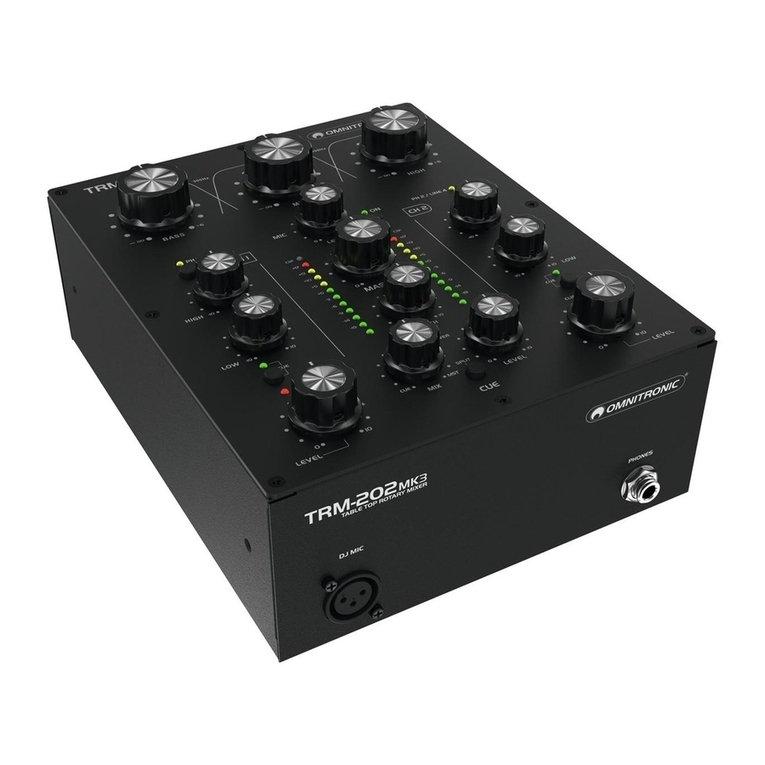
Omnitronic
Omnitronic TRM-202MK3 User manual

Omnitronic
Omnitronic LH-OIO User manual
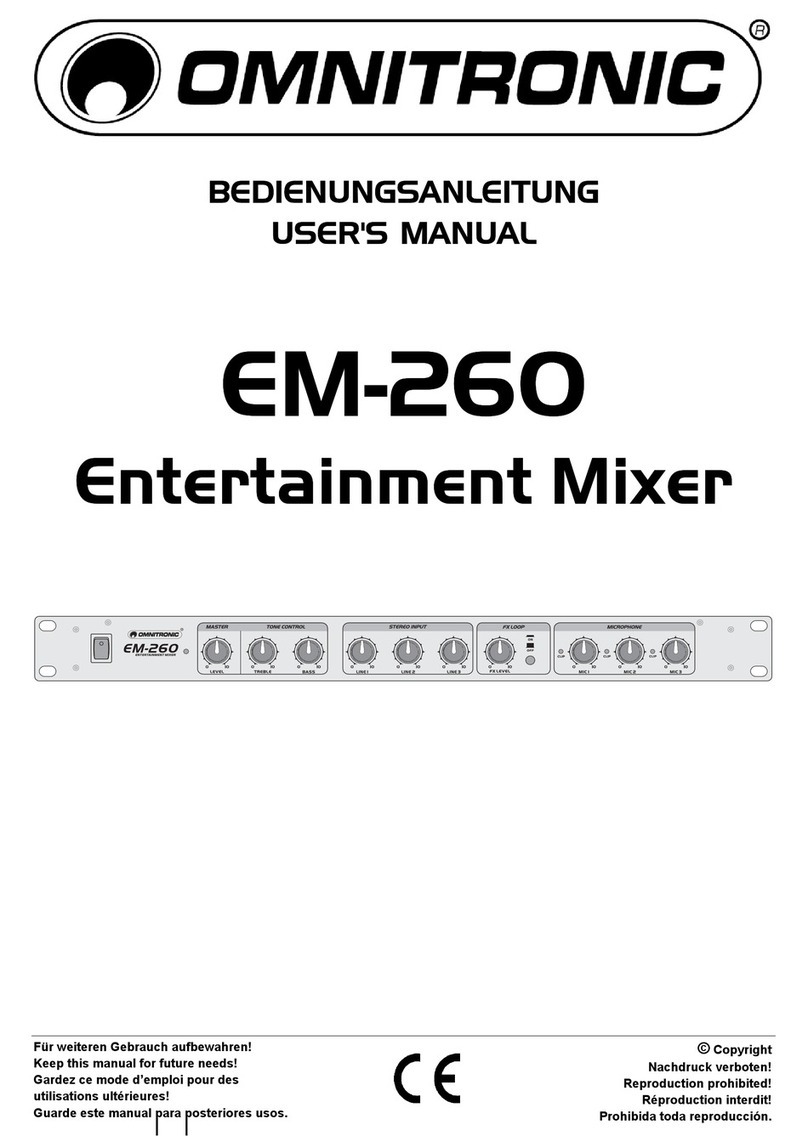
Omnitronic
Omnitronic EM-260 User manual
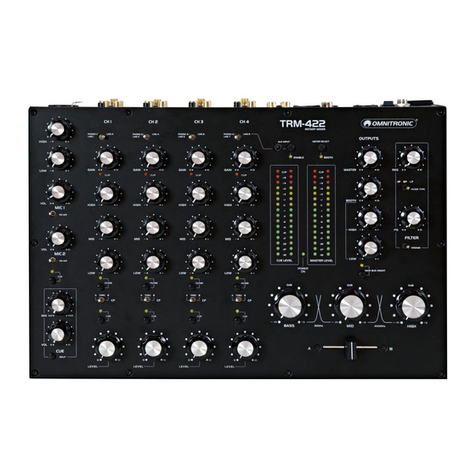
Omnitronic
Omnitronic TRM-422 User manual

Omnitronic
Omnitronic RS-1222 User manual

Omnitronic
Omnitronic EM-312 User manual

Omnitronic
Omnitronic EMX-5 User manual

Omnitronic
Omnitronic MMP-1 User manual

Omnitronic
Omnitronic MLM-81 User manual



